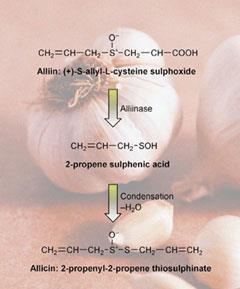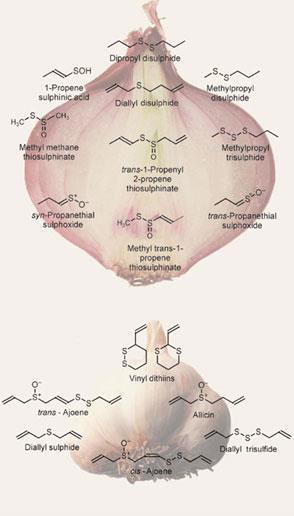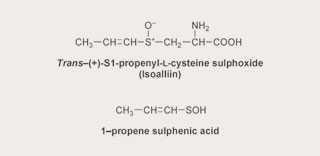New studies into the chemicals present in garlic and onions continue to confirm that these remarkable plants contain a veritable treasure trove of healing agents. Dennis Rouvray investigates.
New studies into the chemicals present in garlic and onions continue to confirm that these remarkable plants contain a veritable treasure trove of healing agents. Dennis Rouvray investigates.
Garlic is literally the stuff of which legends are made. In Homer’s Odyssey we are told, for instance, that the hero Odysseus was prevented from being turned into a pig by the sorceress Circe only because he was given a magic potion consisting of garlic. The potency of garlic and its legendary healing powers have been known for millennia and were perhaps first discovered in Neolithic times. The earliest written record appears on a 5000 year old Babylonian cuneiform tablet that refers to garlic as a medicinal tonic. The ancient Egyptians were especially partial to garlic and one of their medical manuals, now called the Ebers Papyrus, lists no fewer than 22 different drug formulations that are garlic-based. Egyptian pyramid builders were given garlic to maintain their stamina, the virtues of garlic even being inscribed on the Great Pyramid at Cheops. Royal personages were buried with garlic to protect them in the afterlife and remnants of garlic bulbs have been found in several tombs, including that of the Pharoah Tutankhamen buried in 1352 BC. The ancient Roman Empire held garlic in the highest esteem and Roman legionnaires were regularly given garlic to keep up their fighting spirit.
The acclaim garlic received in the ancient world has been matched in more recent times. In an unbroken timeline extending from the ancients to the present day, garlic has been recognised as possessing exceptional qualities. Some of the greatest healers and physicians of the past, including Hippocrates, Aristophanes, Galen, Celsus, Hildegard of Bingen, Paracelsus and Culpeper, have lavished praise on the plant. And Louis Pasteur was the first to describe its antibacterial properties in 1858. Several sacred religious works, including the Talmud, the Bible, and the writings of Mohammed, make positive reference to garlic and recommend its use. Secular writers such as Chaucer and Shakespeare also felt garlic was worthy of comment. More recently, several thousand scientific studies on garlic have been carried out and published in the literature. The twin purposes of the latter were (i) to attempt to elucidate the surprisingly exotic chemistry of garlic, and (ii) to establish whether the extravagant claims made about the therapeutic benefits of garlic can be substantiated. Studies of this kind are of course still ongoing and are beginning to confirm what has long been suspected, namely that garlic is indeed a very special vegetable.
Allium species
According to the classification of Linnaeus, garlic belongs to the lily family of plants, the Liliaceae, and its genus is Allium. The genus now contains well over 600 different species and includes onions, scallions, shallots, chives and leeks. The word garlic derives from old Anglo-Saxon gar, meaning spear, and leac, meaning leek, and refers to the pointed shape of its leaves. The term Allium most likely derives from the ancient Celtic word ?ll, meaning pungent. Interestingly, the French call garlic ail and the Italians aglio. Both garlic and onions are pungent because of the many organic sulphur compounds they contain, and because of their similar chemistry we shall discuss them together from here on. Garlic has the species name Allium sativum and onion is Allium cepa. The total sulphur content of these species amounts to about one per cent of their dry weight and this is there to prevent the plants from being eaten alive by pests. The sulphur compounds were thus evolved for defensive purposes and not for the benefit of humans. In fact, the species becomes toxic to humans if eaten in large quantities and for this reason it is not a good idea to consume more than five bulbs of garlic or three large onions at one sitting.
That said, it is the sulphur-bearing compounds that are primarily responsible for the health-promoting properties of garlic and onions, and consequently the great majority of the investigations carried out on these species to date have focused on either the chemistry or the medicinal value of these compounds. Starting with some pioneering studies carried out in Germany in the 1840s, several hundred chemists have subsequently had their work cut out to determine the structures of the numerous chemical compounds involved and to understand how they react with one another and with air. Some of the major research groups that have explored this area include those of Arthur Stoll of Sandoz Pharmaceuticals, Basel, Switzerland (1940s-50s), Artturi Virtanen of the Biochemical Institute, Helsinki, Finland (1950s-60s), Eric Block now of the State University of New York at Albany, US (1970s-90s), and Heinrich Koch of the University of Vienna, Austria (1980s-90s). Their collective endeavours have succeeded in giving us a detailed picture of the relevant chemistry. A number of the chemical compounds derive their name from the genus designation Allium, and this is also the case for the allyl group, CH2=CH-CH-, which is present in some of these compounds.
Allium chemistry
Somewhat surprisingly, garlic bulbs that remain undisturbed and intact contain no strongly odiferous compounds and display virtually no physiological activity. It is the act of cutting into or crushing these bulbs that releases such substances. Initially, the plant enzyme alliinase is released and this acts on the odourless alliin ((+)-S-allyl-L-cysteine sulphoxide) in the bulbs to produce 2-propenesulphenic acid which then dimerises in air to form the pungent and highly volatile allicin (diallyl thiosulphinate) as shown in Scheme 1. In the case of onions, damaging the bulbs results in a very similar sequence of reactions. To start with the enzyme alliinase acts on isoalliin, a molecule structurally isomeric with alliin and characterised as trans-(+)-S-1-propenyl)-L-cysteine sulphoxide with the double bond now adjacent to the sulphur atom. This action produces (+)-S-1-propenyl-L-cysteine which quickly condenses, forming a number of thiosulphinates, including methyl-1-propene thiosulphinate and 1-propenyl methane thiosulphinate. It is worth noting that alliin was the first natural product known to incorporate both an asymmetric carbon atom and an asymmetric sulphur atom.
The point when the thiosulphinates begin to form is actually the starting point for a whole cascade of chemical reactions that occur in damaged garlic and onion bulbs. The thiosulphinates react with the oxygen in the air and also with themselves to generate an eclectic range of organic sulphur compounds, some of which are so well known that they are immediately recognisable and others which are so rare that they have given rise to new study areas in natural products chemistry. Over 100 sulphur compounds are formed in garlic and in all probability a similar number are produced in onions, though in this case this number is less certain without more studies. It is this series of sulphur compounds that typically contains not only the most malodorous but also the most physiologically active molecules. It would be impossible to mention more than a handful of these molecules here, but several of those found in both garlic and onions are shown in Scheme 2.

Scheme 1: Formation of the pungent allicin from the action of alliinase on alliin in garlic |
The rich variety of sulphur compounds released by garlic and onions are often seen as a mixed blessing. Beginning with the negative aspects, we know that cut onions produce a tear-inducing substance known as a lacrimatory factor, and that when garlic is consumed it leads to halitosis, ie garlic breath. The lacrimatory effect is experienced a few seconds after an onion is sliced, that is as soon as the enzyme alliinase has had time to act on the isoalliin to yield 1-propenesulphenic acid which rapidly rearranges to form the lacrimatory factor syn-propanethial sulphoxide (Scheme 3). The bad breath - and perspiration odours - caused by eating garlic come from several of the sulphide compounds generated in the cascade of compounds formed when the thiosulphinates formed react with oxygen. These compounds include allyl methyl sulphide, allyl methyl disulphide, diallyl sulphide and diallyl disulphide and it seems that they reach the lungs and the sweat glands via the blood. A much more positive response is usually elicited to the smell of frying onions which is due to the presence in the air of methylpropyl disulphide, methylpropyl trisulphide, allylpropyl disulphide, and dipropyl trisulphide among others.

Scheme 2: Sulphur molecules found in onions and garlic |
Helpful not harmful
One outstanding benefit that the sulphides formed by garlic and onions are able to confer on humans and other mammals is their capacity to prevent and heal a very wide range of diseases. Literally thousands of studies have been carried out to date to establish the effectiveness of alliaceous plant products. Most of these studies were concerned with the outcome of consuming either raw or cooked bulbs in their entirety, though certain of them relied on extracts derived by steam distilling the plants or dissolving their active ingredients in vegetable oils. Only on comparatively rare occasions have the effects produced by individual sulphides been investigated. The list of ailments that can be treated, or at least ameliorated, by garlic is exceptionally long and not equalled by any other medicinal plant. Only onions come close to having the same kind of efficacy. Garlic has been shown to display powerful antibiotic activity and has the distinction of functioning as an antibacterial, antiviral, antifungal, antiprotozal and antiparasitic agent and inhibits both Gram positive and Gram negative bacteria. For heart and circulatory disorders garlic has beneficial effects on hyperlipidemia, hypercholesterolemia and atherosclerotic lesions and in addition contains vasodilative compounds that improve blood fluidity and reduce platelet aggregation. Garlic is also anticarcinogenic, antitumour and antimutagenic in nature and is therefore prophylactic against many different types of cancer. Other conditions for which garlic is valuable include AIDS, arthritis, diabetes, influenza, leprosy and tuberculosis. The healing role of onions has not been nearly as thoroughly explored as that of garlic, but the studies that have been undertaken so far seem to confirm that onions are second only to garlic in their healing powers.
In addition to physiologically active sulphur compounds, garlic and onions contain a variety of other health-giving ingredients. Among these are several vitamins, with thiamine (vitamin B1), riboflavin (vitamin B2) and ascorbic acid (vitamin C) being well represented. Virtually all of the trace elements necessary for good health are also present and in particular there are useful quantities of manganese, iron, phosphorus, selenium, and chromium. The amount of each trace element found in the plant depends very much on the soil in which it is grown. Thus, experiments carried out by Eric Block in the mid-1990s on garlic grown in selenium-enriched soils have revealed that selenium can substitute for sulphur in many of the sulphides formed in cut garlic. Examples of the compounds formed included dimethyl selenide, CH3-Se-CH3, and dimethyl diselenide, CH3-Se-Se-CH3, though most of the selenium appeared to be extant in the molecule of Se-methyl selenocysteine. Among the many other chemical constituents of garlic mention should be made of the fatty acids which are comprised principally of linolenic acid, palmitic acid, oleic acid, and ?-linolenic acid, all of which are noted for their health benefits. So-called garlic oil on sale in stores however is produced by steam distillation of crushed garlic bulbs and contains primarily oil-soluble allyl sulphides and virtually no fatty acids.

Scheme 3: Formation of the lacrimatory factor syn-propanethial sulphoxide |

This image replaces the one above for scheme 3 |
The celebrity status enjoyed by garlic since the dawn of civilization seems to have been amply confirmed by the several thousand scientific experiments that were carried out on it beginning in the 1840s and extending down to the present. In the case of onions, although substantially less experimentation has been done on them, it has become increasingly evident that because their underlying chemistry is so similar to that of garlic it is only a matter of time until their health-promoting characteristics are equally well established. The highly prized potency of both garlic and onions has been reflected in the various designations assigned to them. They have been referred to as functional foods, designer foods and health foods. Such terms are used to imply that these vegetables contain more than ordinary nutrients that simply nourish and are in fact the hosts to highly bioactive constituents that are capable of preventing or healing a range of physical maladies. These constituents are now therefore commonly described as nutraceutical foodstuffs. For over a decade, garlic and onions have been a focus of interest in the designer foods programme of the National Cancer Institute in Bethesda, Maryland, US. Research performed there has shown that the regular consumption of garlic has been associated with a marked decrease in the incidence of breast, colon, larynx, prostate and stomach cancers. As programmes of this type continue to validate the role of allium spices in the broad domains of health and healing, a paraphrase of the words of Winston Churchill seem particularly apt. Never in the annals of human history has so much praise been bestowed by so many on so humble a plant species. And all of it is richly deserved.
Acknowledgements
Dennis Rouvray is a chemistry professor working in the Department of Chemistry at the University of Georgia, Athens, Georgia, US.
References
- A Virtanen, Angew. Chem. Int. Ed., 1962, 1, 299
- E Block, Angew. Chem. Int. Ed., 1992, 31, 1135
- E Block, Sci. Am., 1985, 252, 114.
- K C Srivastava et al, S. Afr. J. Sci., 1995, 91, 68
- H P Koch and L D Lawson, Garlic: The Science and Therapeutic Application of Allium sativum L. and Related Species, Williams and Wilkins, Baltimore, Maryland, 1996
- A T Fleischauer and L Arab, J. Nutrition, 2001, 131, 1032S
- J A Milner, Adv. Exp. Med. Biol., 2001, 492, 69






No comments yet